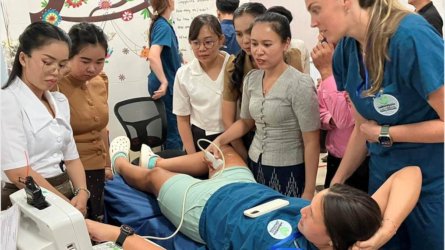Become a CRNA
A Dynamic, Rewarding Career Awaits You
Certified Registered Nurse Anesthetists Fact Sheet
Certified Registered Nurse Anesthetists (CRNAs/nurse anesthesiologists) play a vital role in successful surgeries and making other medical procedures pain-free. These advanced-practice nurses also play a leading part in moving modern medicine forward, as they:
- Provide safe, high-quality, patient-centered care
- Reassure and comfort patients before, during, and after medical procedures
- Bring anesthesia services to practice settings that would otherwise lacking them
- Make healthcare more cost-effective
Join a fast-growing, trusted profession — become a CRNA/nurse anesthesiologist.
Looking for specifics on how to become a anesthesia expert? Keep reading for insights and answers.
What to Know About Becoming a CRNA/nurse anesthesiologist
Minimum Education Required to Become a CRNA/nurse anesthesiologist
Minimum Education Required to Become a CRNA/nurse anesthesiologist
CRNA/nurse anesthesiologist preparation requires at least 8–8.5 calendar years of education and experience. You will need:
- A baccalaureate or graduate degree in nursing or another appropriate major
- An unencumbered license as a registered professional nurse and/or APRN in the United States or its territories
- At least one year of full-time work experience (or its part-time equivalent) as a registered nurse in a critical care setting
- Graduation with a minimum of a master’s degree from a nurse anesthesia educational program accredited by the Council on Accreditation of Nurse Anesthesia Educational Programs (COA)
Education Stats and Facts
Education Stats and Facts
As of July 2024:
- 141 accredited nurse anesthesia programs in the United States and Puerto Rico, using more than 2,598 active clinical sites
- All nurse anesthesia programs approved to award doctoral degrees for entry into practice
Nurse anesthesia programs range from 36–51 months, depending on university requirements.
Graduates of nurse anesthesia educational programs have an average of 9,432 hours of clinical experience.
More than 2,400 resident registered nurse anesthetists graduate each year, then pass the National Certification Examination to become CRNAs/nurse anesthesiologists.
Today, more than 65,000 CRNAs/nurse anesthesiologists (CRNAs and CRNA residents) work in practice settings of every type.
Applying to a Nurse Anesthesia Program
Applying to a Nurse Anesthesia Program
What You Should Know
The 100+ accredited nurse anesthesia education programs across the U.S. have similar, but distinct, application processes. Common requirements include:
- Prerequisites, such as a GPA of 3.0 or higher, a GRE score of approximately 300, and one year of acute-care nursing experience
- A curriculum vitae indicating significant or advanced career achievements
- An interview (in-person, virtual, or phone) with program administrators/instructors
- A writing test
Every RN and APRN aspiring to become a CRNA/nurse anesthesiologist is encouraged to join AANA to get the inside track on becoming an anesthesia expert. As an AANA member, you’ll have access to up-to-date, actionable, and practical tools and knowledge to help you achieve your personal and professional goals. And as you prepare for your future career, you’ll also learn from, network with, and receive guidance from current residents, practicing CRNAs/nurse anesthesiologists, and program directors.
CRNA/nurse anesthesiology school is extremely competitive. And each year, approximately 3,000 RNs and APRNs become nurse anesthesia residents (students) in accredited programs. AANA membership does not guarantee admission, but it can give aspiring CRNAs/nurse anesthesiologists an advantage in preparing their application to CRNA/nurse anesthesiology school.
Program Application and Admission Insights
Program Application and Admission Insights
Unique perspectives on what to expect when applying to a CRNA program and working as a CRNA/nurse anesthesiologist.
- Guide to CRNA Admission
- So You Want to Be a Nurse Anesthetist
- From RN to Nurse Anesthetist (CRNA): This is Why I Chose a Doctorate Over MSN
Program administrators will also consider your passion for the profession, leadership attributes, and willingness to learn.
History of the Profession
History of the Profession
Nurse anesthetists have provided anesthesia care to patients in the United States for more than 150 years. Nurses first provided anesthesia on the battlefields of the American Civil War. During World War I, nurse anesthetists became the predominant providers of anesthesia care to wounded soldiers on the front lines.
The Certified Registered Nurse Anesthetist (CRNA/nurse anesthesiologist) credential came into existence in 1956 and in 1986 CRNAs/nurse anesthesiologists became the first nursing specialty accorded direct reimbursement rights from Medicare. In 2001, the Centers for Medicare & Medicaid Services (CMS) changed the federal physician supervision rule for nurse anesthetists to allow state governors to opt out of this facility reimbursement requirement.
Today, CRNAs/nurse anesthesiologists have full practice authority in every branch of the military and are the primary providers of anesthesia care to U.S. military personnel on the front lines, navy ships, and aircraft evacuation teams around the globe.
Prolific Providers
Prolific Providers
CRNAs/nurse anesthesiologists safely administer more than 58 million anesthetics to patients each year in the United States. As advanced practice registered nurses, they are among the nation’s most trusted professions according to Gallup. Nurses have topped Gallup’s Honesty and Ethics list for 22 consecutive years and are ranked second in U.S. News & World Report’s 2024 “Best Health Care Jobs” report.
CRNAs/nurse anesthesiologists practice in every setting in which anesthesia is delivered: traditional hospital surgical suites and obstetrical delivery rooms; critical access hospitals; ambulatory surgical centers; ketamine clinics; the offices of dentists, podiatrists, ophthalmologists, plastic surgeons, and pain management specialists; and U.S. military, Public Health Services, and Department of Veterans Affairs healthcare facilities.
Crucial Providers in Rural America
Crucial Providers in Rural America
CRNAs/nurse anesthesiologists represent more than 80% of the anesthesia providers in rural counties. Many rural hospitals are critical access hospitals, which often rely on independently practicing CRNAs/nurse anesthesiologists for anesthesia care. Half of U.S. rural hospitals use a CRNA-only model for obstetric care, and they safely deliver pain management care, particularly where there are no physician providers available, saving patients long drives of 75 miles or more.
Safe, High-quality Anesthesia Professionals
Safe, High-quality Anesthesia Professionals
Numerous peer-reviewed studies have shown that CRNAs are safe, high quality and cost-effective anesthesia professionals who should practice to the full extent of their education and abilities. According to a 2010 study published in the journal Nursing Economic$, CRNAs acting as the sole anesthesia provider are the most cost-effective model for anesthesia delivery, and there is no measurable difference in the quality of care between CRNAs and other anesthesia providers or working within another anesthesia delivery model. Researchers studying anesthesia safety found no differences in care between nurse anesthetists and physician anesthesiologists based on an exhaustive analysis of research published in the United States and around the world, according to a scientific literature review prepared by the Cochrane Collaboration, the internationally recognized authority on evidence-based practice in healthcare. A study published in Medical Care (June 2016) found no measurable impact in anesthesia complications among states with and without nurse anesthetist scope of practice or practice restrictions.
Practicing Nursing at the Highest Level
Practicing Nursing at the Highest Level
CRNAs/nurse anesthesiologists provide anesthesia in collaboration with surgeons, dentists, podiatrists, physician anesthesiologists, and other qualified healthcare professionals.
When anesthesia is administered by a nurse anesthetist, it is recognized as the practice of nursing; when administered by a physician anesthesiologist, it is recognized as the practice of medicine. Regardless of whether their educational background is in nursing or medicine, all anesthesia professionals give anesthesia the same way.
Autonomy, Responsibility, and Respect
Autonomy, Responsibility, and Respect
As advanced practice registered nurses, CRNAs/nurse anesthesiologists practice with a high degree of autonomy and professional respect. CRNAs/nurse anesthesiologists are qualified to make independent judgments regarding all aspects of anesthesia care based on their education, licensure, and certification. They are the only anesthesia professionals with critical care experience prior to beginning formal anesthesia education.
Cost-effective, Highly Efficient Care Providers
Cost-effective, Highly Efficient Care Providers
The all-CRNA model, where anesthesia delivery is staffed and directed by CRNAs avoids duplication of services, promotes efficient utilization of anesthesia providers, and reduces cost. As interests compete for limited resources in healthcare, groups and facilities seeking to minimize the cost of anesthesia services can achieve excellent cost savings as compared to other anesthesia practice models by the implementation of an all–CRNA model.
Direct Reimbursement
Direct Reimbursement
Legislation passed by Congress in 1986 made nurse anesthetists the first nursing specialty to be accorded direct reimbursement rights under the Medicare program and CRNAs/nurse anesthesiologists have billed Medicare directly for 100% of the physician fee schedule amount for services. In 2020, U. S. Congress passed legislation that included a nondiscrimination provision to prohibit health plans from discriminating against qualified licensed healthcare professionals, such as CRNAs/nurse anesthesiologists and other non-physician providers, solely based on their licensure.
Supervision Opt-Out
Supervision Opt-Out
In 2001, CMS changed the federal physician supervision rule for nurse anesthetists to allow state governors to opt out of this facility reimbursement requirement (which applies to hospitals and ambulatory surgical centers) by meeting three criteria:
- Consult the state boards of medicine and nursing about issues related to access to and the quality of anesthesia services in the state,
- Determine that opting out is consistent with state law, and
- Determine that opting out is in the best interests of the state’s citizens.
To date, 25 states and Guam have opted out of the federal physician supervision requirement. Additional states do not have supervision requirements in state law and are eligible to opt out should the governors elect to do so.
Malpractice Premiums
Malpractice Premiums
On a nationwide basis, the average 2023 malpractice liability insurance premium for self-employed CRNAs/nurse anesthesiologists was 25 percent less than it was in 1996. When adjusted for inflation through 2020, the reduction in premiums was even greater, at 71 percent.
AANA Membership
AANA Membership
AANA membership is open to CRNAs/nurse anesthesiologists — both practicing and retired — as well as current and aspiring nurse anesthesia residents. More than 65,000 of the nation’s CRNAs/nurse anesthesiologists and residents are members of AANA. That’s 88 percent of all U.S. nurse anesthetists/nurse anesthesiologists.
Stories About CRNAs/nurse anesthesiologists

news
CRNA saves life mid-flight, earns recognition from TV talk show host
March 5, 2025
CRNA profiles

news
A CRNA’s Non-Linear Path to Success
February 24, 2025
CRNA profiles

news
Advancing Anesthesia Care in Laos: A CRNA’s Global Mission to Educate Nurse Anesthetists
February 5, 2025
CRNA profiles

news
CRNAs drive innovation, ensure high-quality care in pediatric anesthesia
January 23, 2025
CRNA profiles

news
A Chance Encounter at 35,000 Feet
January 22, 2025
CRNA profiles

news
AANA Wellness and one CRNA’s journey to sobriety
December 16, 2024
CRNA profiles
